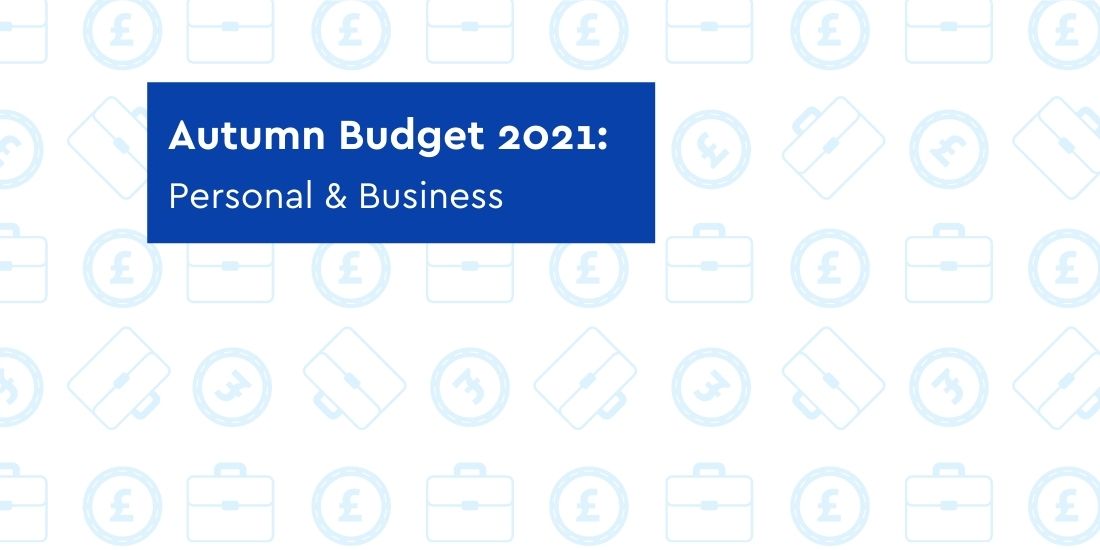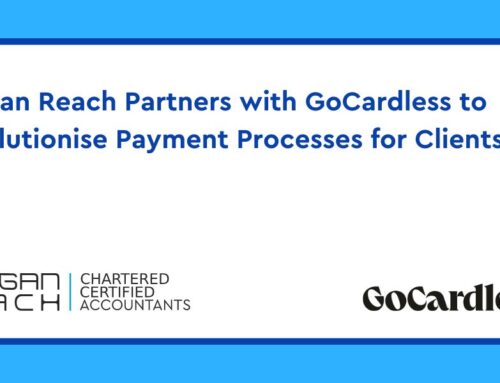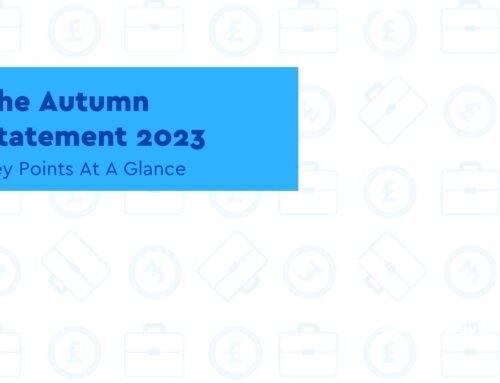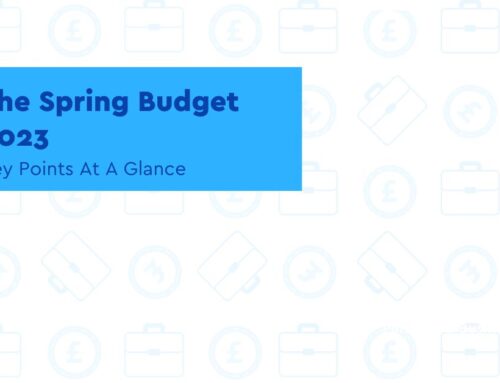Autumn Budget 2021: Personal & Business
Introduction
The Chancellor, Rishi Sunak delivered his second Budget this calendar year with the Covid 19 virus continuing to have an impact, both emotionally and financially, on individuals, families, businesses and the UK economy as a whole. Various support for businesses affected by the pandemic, such as the Coronavirus Job Retention Scheme and the Self-Employed Income Support Scheme had ceased at the end of September.
Rishi could take comfort in the fact that the economy is on the upturn but there are still challenges surrounding rising heating and lighting costs, a shortage of HGV drivers, unfilled vacancies in certain sectors and the concerns for the low paid and unemployed of making ends meet when faced with rising prices.
Personal Allowances
It is important to note that the tax rates and thresholds are complicated by the fact that the power to vary the tax rates and thresholds of Non-Savings, Non-Dividend income for Scottish taxpayers have been devolved to the Scottish Parliament since April 2017. With the exception of the tax thresholds, similar powers have been passed over to the National Assembly of Wales since April 2019 in respect of Welsh resident taxpayers. The Income Tax Personal Allowance and all other elements of the Income Tax system remain part of the Chancellor’s responsibility.
The Chancellor back in the last Budget froze the Personal Tax Allowance (PTA) at £12,570 until April 2026 for all UK taxpayers.
The phased withdrawal of the personal allowance remains at £100,000 with it being fully removed once the income has reached £125,140.
Top Tip – it is always worth considering if there is any action which can be taken to ensure individual income is below this £100,000 threshold, as the effective tax rate for the £25,140 above this threshold is 60% or 61% (Scotland).
Income Tax Rate Bands for taxpayers in England, Wales and Northern Ireland
Starting rate for savings will remain at £5,000.
Once the individual’s Personal Tax Allowance has been exceeded the balance is then taxed as follows:-
Rest of UK Income Tax Rates 2022-23
| Band | Rate |
| £0 to £37,700 | 20% |
| £37,701 to £150,000 | 40% |
| Over £150,000 | 45% |
The tax rate bands will remain the same until April 2026. The Welsh and Scottish Parliaments are able to change the income tax rates and thresholds on non-savings, non-dividend income in respect of Scottish and Welsh taxpayers. The Scottish Budget will be on Thursday, 9th December 2021. The Welsh Budget has been set for 20th December 2021.
It is worth noting that the Dividend Allowance remains at £2,000. However, pre this Budget the Government released the Health & Social Care Levy Bill which will increase the taxable rates on dividend income from 6th April 2022;
| Band | Until 5 April 22 | From 6 April 22 |
| Dividend ordinary rate | 7.5% | 8.75% |
| Dividend upper rate | 32.5% | 33.75% |
| Dividend additional rate | 38.1% | 39.35% |
Top Tip – If you pay dividends out of your company, assuming it is possible to do so, it may be worthwhile paying out a dividend prior to 6th April 2022.
Marriage Allowance
The Marriage Allowance which individuals can transfer to their spouse or civil partner, where the recipient is not a higher rate or additional rate taxpayer and they are not in receipt of the married couple’s allowance, remains at £1,260.
It is possible for a claim for the Marriage Allowance to be made in respect of a deceased spouse or civil partner and for that claim to be backdated for up to four years.
National Insurance
The annual National Insurance (NI) threshold for an individual where they start to pay NI on their earned income will increase to £9,880 (£823 per month).
The Health & Social Care Levy will increase the National Insurance liability by 1.25% from April 2022 for one year only. From April 2023 the Levy will be charged separately. It is also important to note that people over the state pensionable age, who are working, will also be required to pay the Levy from April 2023.
| National Insurance (NI) | 2021/22 | 2022/23 |
| Class 1 NI employees – earnings between £9,880 (£9.568 2021/22) – £50,270 | 12% | 13.25% |
| Class 1 NI employees – earnings in excess of £50,270 | 2% | 3.25%. |
| Class 1 NI employers – earnings in excess of £9,100 (£8,892 2021/22) | 13.8% | 15.05% |
| Class 1A Benefits in kind | 13.8% | 15.05% |
| Class 1B NI PAYE settlement agreements | 13.8% | 15.05% |
| Class 4 NI self-employed – Profits between £9,880 (£9.568 2021/22) – £50,270 | 9% | 10.25% |
| Class 4 NI self-employed earnings in excess of £50,270 | 2% | 3.25% |
The self-employed Class 2 NIC Small Profits Threshold for 2022/23 £6,725 (£6,515 2021/22). The weekly contribution for 2022/23 – £3.15 (£3.05 – 2021/22).
Top Tip – it is strongly advised you should review your NI records at least every 5 years, whilst it is fresh in your memory bank, to ensure they are correct and up to date. National Insurance contributions protect your rights to certain state benefits and contribute to calculating your state pension. We are happy to carry out this review for you.
Top Tip – from April 2022, if an employer operates within a Government approved designated area, known as a Freeport, it may be entitled to pay zero % employers NI on the first £25,000 of a newly employed person’s salary, as long as that individual spends at least 60% of their working time within the Freeport site.
Top Tip – if you have more than one employment you may pay too much employees NI during the course of the tax year. HMRC can request the second employer to operate a lower NI rate for the current tax year through the PAYE system. If the situation arose in prior years an NI repayment can be claimed.
The National Minimum Wage
The National Minimum Wage (NMW) and the National Living Wage (NLW) rates will increase from 1st April 2022:
| NWL – Worker 23+ | £9.50 per hour |
| NMW – Worker 21 – 22 | £9.18 per hour |
| NMW – Worker 18 – 20 | £6.83 per hour |
| NMW – Worker 16 – 17 | £4.81 per hour |
| NMW – Apprentice | £4.81 per hour |
Top Tip – if you are an employer carry out a regular review to ensure that you are adhering to the NMW Regulations. Failure to comply, can result in a penalty of up to 200% of the liability due and any underpayment of wages can go back up to 6 years using the current NMW rates.
Inheritance Tax
The tax rates and nil rate band for Inheritance Tax purposes remain the same until April 2026. The nil rate band at £325,000 and the residence nil rate band (RNRB) at £175,000 (the commencement of the tapering off of the RNRB remains at £2 million).
Top Tip
Top Tip – do you know the value of your Estate for Inheritance Tax purposes? Remember the tax on death, after taking account of reliefs and exemptions, is 40%. With planning you can potentially mitigate that liability and pass more of your assets over to your loved ones rather than HMRC. Please contact us for an Inheritance Tax review.
Top Tip – you should review your will whenever there is a change of circumstances in your life to ensure that it reflects your current wishes. That could be marriage, divorce, children or grandkids and inheritance etc. Are you confident that your current will takes account of the many tax legislation changes over the years and is therefore tax efficient?
ISA’s and Child Trust Funds
The ISA subscription limit from April 2022 will remain at £20,000. The annual subscription limit for Junior ISAs and Child Trust Funds (CTF) will also stay at £9,000 each for the 2022/23 tax year.
Top Tip – the Government paid between £500 and £1,000 into a CTF for those children born between 1.9.2002 and 2.1.2019. The CTF can be legally accessed when the child reaches the age of 18. It is believed that over 2 million fund holders are unaware of the CTF existence. Do you know anybody who fits the eligibility criteria?
Capital Allowances
For those businesses investing in plant and machinery, the temporary 100% Annual Investment Allowance (AIA) of £1 million, was due to come to an end on 31st December 2021. This cut-off date has now been extended to 31st March 2023. From 1st April 2023 the AIA will be £200,000.
Top Tip – Companies who invest in new plant and machinery (P&M) which ordinarily qualifies for the 18% main rate of writing down allowance (WDA) for capital allowance purposes may, in some cases, potentially claim an enhanced temporary 130% first year allowance. An enhanced first year allowance of 50% is available on investment into new plant and machinery which would ordinarily qualify for 6% WDA. These temporary allowances remain in place until 31st March 2023.
Company Taxation
As announced in the March Budget, the Corporation Tax (CT) rate is to remain at 19% until 31st March 2023. From 1st April 2023, the Corporation Tax main rate for non-ring fenced profits will be increased to 25% applying to profits over £250,000. A small profits rate (SPR) will also be introduced for companies with profits of £50,000 or less so they will continue to pay Corporation Tax at 19%. The small profits rate will not apply to close investment-holding companies. Companies with profits between £50,000 and £250,000 will pay tax at the main rate reduced by a marginal relief providing a gradual increase in the effective Corporation Tax rate. The lower and upper limits will be proportionately reduced for short accounting periods and where there are associated companies.
From 1st April 2023, the Bank Corporation Tax Surcharge will be 3% above the normal CT rate of 25%. The Surcharge allowance per banking group, will be increased from £25 million to £100 million. This will impact upon building societies as well as banks.
Top Tip – There are a number of different ways to legitimately mitigate your Corporation Tax liability, for example, maximising your capital allowances position, claiming Structural Buildings Allowance, Research & Development tax relief/allowance or the Patent Box relief or by way of maximising the pension opportunities for directors/employees. We are happy to offer a pre-year-end review to ensure that these types of opportunities are not missed.
Top Tip – Don’t forget that companies which make losses during accounting periods ending in the period 1st April 2020 to 31st March 2022 can carry them back up to 3 years to set against profits from the same trade arising in those years. Normally a company can only go back 12 months. The amount of trading losses which can be carried back to the preceding year remains unlimited. The two prior years to that, there is a restriction of £2,000,000 per year.
Unincorporated businesses
Presently, a business’s profit or loss for a tax year is usually based the accounting date ending in that tax year. For example, if your accounts to 30th April 2021 shows net profit of £30,000, that is taxable in the 2021/22 tax year. This is called the ‘basis period’.
From April 2024 the basis period will be tied to the actual tax year, irrespective of when the business draws up their accounts. The transitional year for moving across to this new basis period will be the 2023/24 tax year.
This will impact upon those businesses whose accounting period does not end between 31st March and 5th April. Those ‘businesses’ could be self-employed traders, including individuals with a profession or vocation; partners in trading partnerships; other unincorporated entities with trading income, such as trading trusts and estates and non-resident companies with trading income charged to Income Tax
Top Tip – For those business potentially affected by this change to the basis period, it could result in a significant increase in tax to pay in January and July 2025. Now is the time to review that situation, as there may be ways to mitigate that tax uplift.
.
Top Tip – There are many ways to utilise self-employed trading losses, not just against trading profit or other income for tax purposes but also for mitigating Class 4 National Insurance. One of those is a temporary Covid concession which enables losses made in the 2020/21 and/or 2021/22 tax years to be carried back to set against trading profits in the prior 3 years. We can help you review the various options to see which one is the most appropriate for you.
Employment Allowance
The Employment Allowance, which can be set off against the employer’s National Insurance liability, will remain at £4,000 from April 2022.
Research and Development (R&D) and Patent Box
The 230% R&D tax relief on expenditure incurred in respect of R&D work remains in place as does the 100% R&D allowance on capital expenditure incurred on cost of a building used for R&D purposes.
R&D tax reliefs will be reformed to support modern research methods by expanding qualifying expenditure to include data and cloud costs, and refocus support towards innovation in the UK. These changes will take effect from April 2023.
The 10% Corporate Patent Box relief in respect of profits arising from a patent you hold or where you have an exclusive licence over it has been left untouched.
Top Tip – If you are a company which is creating, developing or enhancing a product, whatever it might be, then you may be entitled to the R&D tax relief. Potentially you can go back 2 accounting periods. It could be any business sector (for example – software, clothing, manufacturing, engineering, marine, aerospace, rail, cosmetics, packaging, construction, medical devices, pharmaceuticals etc.). Please contact us if you would like to see whether you eligible or not.
VAT
The taxable turnover threshold for determining whether a person must register for VAT will remain at £85,000 and the point at which a person can apply to deregister will also remain at £83,000 until 31st March 2024.
The Second Hand Motor Vehicle Refund Scheme could affect businesses that buy eligible used motor vehicles in Great Britain (GB) that are removed for resale to Northern Ireland (NI) or the European Union (EU).
Presently, under the Northern Ireland Protocol, motor vehicle dealers in NI may not use the VAT margin scheme on motor vehicles purchased in GB. This means that they must account for VAT in full on sales of these vehicles, potentially increasing prices for consumers or increasing costs for businesses. This risks undermining the trade in motor vehicles in NI.
Under the Second Hand Motor Vehicle Refund Scheme, eligible businesses who remove used motor vehicles from GB for resale in NI or the EU may be able to claim a refund in respect of VAT. This means that NI motor vehicle dealers will remain in a similar financial position as those applying the VAT margin scheme elsewhere in the UK.
Top Tip – if you have voluntarily registered for VAT, starting from April 2022, you will be required to keep digital records and, using compatible software, digitally file VAT Returns. If you are not already doing this, it would be wise to prepare for these changes now rather than leave it to the last minute.
Stamp Duty Land Tax (SDLT)
The SDLT rate for residential properties remain unchanged from those set at 1st October 2021 which effectively were the rates in place pre the pandemic. The SDLT commercial rate also remains unchanged.
The 3% SDLT surcharge when acquiring a second residential property remains as it is.
The Scottish and Welsh Government set their own Land Transaction tax rates.
Top Tip – On many occasions when acquiring either commercial or residential properties, the incorrect amount of SDLT (England and Northern Ireland), Land Transaction Tax (Wales) and Land and Buildings Transaction Tax (Scotland) is paid over. If you would like our Land Transaction Tax specialist to review the property acquisitions, which have taken place over the past 12 months, please contact us. If they believe a refund is due they are happy to carry out the claim on a ‘no win no fee’ basis.
Pensions
The pension lifetime allowance limit (PLTA) will remain frozen at £1,073,100 until April 2026. Any excess attracts a tax charge of 25% if it is withdrawn as an income (for instance from an annuity or a drawdown arrangement) or 55% if it is withdrawn as a cash lump sum.
When calculating whether or not an individual is liable to suffer a pension tax charge the two threshold criteria will remain in line with the present tax year. The threshold income limit will be £200,000 and the adjusted income limit will rise to £240,000.
The government will legislate to increase the earliest age at which most pension savers can access their pensions without incurring an unauthorised payments tax charge, the normal minimum pension age, from 55 to 57. This increase will have effect from 6 April 2028.
The Scheme Pays reporting and payment deadlines will be extended. This will allow an individual to ask their pension scheme to settle their annual allowance charge of £2,000 or more from a previous tax year by reducing their future pension benefits. The changes will have effect from 6 April 2022.
Top Tip – It is worth having an annual pension review, to ensure you maximise the use of all the pension allowances which may be available to you and to do so in the most tax efficient way. Also it is important to check that you have not breached the very onerous lifetime allowance pension limit nor the pension tax charge itself. We are happy to carry out this review for you.
Capital Gains Tax
The annual exempt amount for individuals for gains on the disposals of assets will remain at £12,300 until April 2026. As regards Trusts and Personal Representatives the exemption will also be frozen at £6,150 until April 2026.
The time limit for submitting a Capital Gains Tax Return and associated tax payment has been extended from 30 days to 60 days. This will have an effect for disposals that complete on or after 27th October 2021.
This applies to UK resident taxpayers where a taxable gain arises upon the sale of a UK residential property. If the property is of mixed use, only the residential element of the gain needs to be reported within the 60 day timeframe.
This also applies to non-UK residents who dispose of an interest in UK property (residential or commercial) or in UK land, irrespective of whether or not a taxable gain arises.
Top Tip – Pre disposing of the property or land, seek tax advice from us, as you may be able to mitigate or wipe out the capital gains tax liability with planning and maximising a number of tax reliefs which are available.
Business Rates (England)
Business rates in Northern Ireland, Scotland and Wales are set by the devolved Governments.
There is a 50% business rates discount for the retail, hospitality, and leisure sectors in England in 2022-23, up to a maximum of £110,000
Measures also included relief for those adopting solar panels and a 12 month rate holiday on property improvements.
Green policies
With the Cop 26 Climate Change Summit fast approaching, the Chancellor has announced a number of green measures.
A Plastic Packaging Tax (PPT) will be charged on packaging manufacture in, or imported into, the UK, where the material used contains less than 30% recycled plastic. Where the packaging imported already contains other goods, the tax will only apply to the plastic packaging itself.
This will come in to force from 1st April 2022. The rate of tax will be £200 per metric tonne of plastic packaging.
Top Tip – where the intention is to export plastic packaging it may be possible to defer the PPT up to 12 months as long as certain conditions are met. If the packaging is actually exported within that period of time, the PPT liability could be cancelled.
Van benefits
Vans which emit CO2 emissions – benefit charge will be £3,600 for 2022/23 (£3,500 – 2021/22). Van fuel benefit charge £688 (2021/22 – £669).
Vans which emit no CO2 emissions – zero benefit charge. Van fuel benefit charge is also zero.
Top Tip – the Court of Appeal recently found in favour of HMRC that certain ‘vans’ were, for tax purposes deemed to be ‘cars’. By winning the case, it significantly increased the tax and national insurance burden on both the company and the employees concerned. In light of this ruling, is it worth reviewing the tax position regarding your company ‘vans’?
Car benefits
The car benefit charge is broadly calculated by applying a certain percentage to the list price of the car. That ‘percentage’ can be based upon a number of factors, such as when the car was first registered, the CO2 emissions emitted and whether it is a petrol, diesel, electric or hybrid car.
From 6th April 2022 the car fuel benefit multiplier will increase to £ 25,300 (from £24,600).
Top Tip – if you are considering your options regarding a company car, leasing or purchasing a vehicle or taking a cash allowance from your business for mileage, why not ask us to review the most cost effective option for you?
Top Tip – if you are using your own electric car for business, you can claim 45p per mile for business mileage. If it is a company electric car then you can claim 4p per mile for business mileage.
Capital Allowances for business cars
The existing 100% First Year Allowance (FYA) for zero emission cars and goods vehicles and equipment for gas refuelling stations will be extended to April 2025. The CO2 emission threshold for business cars entitled to main rate capital allowances (18%) will be 50g/km, with those cars exceeding these limits only entitled to special rate allowances of 6%.
Top Tip – if you are a sole trader or a property landlord whose turnover exceeds £10,000 you may need to be MTD compliant from April 2024. Don’t leave it until the last minute to ensure that your records are kept digitally and that you have HMRC compatible software to digitally file your MTD submissions at the appropriate time. We are happy to give you advice and training in this respect.
Fuel Duty
A freeze in the fuel duty has been announced for the 12th year on the trot.
Airport Duty Rates
There will be a new ‘ultra-long-haul’ band for trips to countries with capitals over 5,500 miles from the UK. The new rate will come into effect from April 2023.
Meanwhile, rates for domestic flights between airports in England, Scotland, Wales and Northern Ireland will be cut by 50% from April 2023.
Wine, Cider and Beer Duty
Taxes on sparkling wine, draught beer and cider are to be cut, but will rise for stronger drinks such as red wine following a shake-up of alcohol duty.
The new system, due to start in 2023 and will mean higher duty for stronger alcohol.
The duty premium on sparkling wines will end and the duty on draught beer and cider served in pubs will be cut.
Landfill Tax
Both the standard and lower rates of Landfill Tax will increase from 1 April 2022 in line with the Retail Prices Index (RPI), rounded to the nearest 5 pence.
Cultural Relief
This is aimed at theatres, galleries, orchestras and museums and will come into effect from 27th October 2021. The Cultural Relief rate will increase as follows:
|
Rate% |
Current rate |
27th Oct 2021 to 31 March 2023 |
2023/24 |
2024/25 (and onwards |
| TTR: non-touring/touring | 20/25 | 45/50 | 30/35 | 20/25 |
| OTR | 25 | 50 | 35 | 25 |
| MGETR: non-touring/touring | 20/25 | 45/50 | 30/35 | 20/25 |
The Museums and Galleries Exhibition Tax Relief (MGETR) includes a sunset clause which meant that the relief was due to expire in April 2022. This will be extended to 31st March 2024.
Film Tax Relief and High End TV Relief
The government will allow film production companies to claim Film Tax Relief for films that were initially intended to be released in cinemas, but which are instead put on streaming services, as long as they meet the criteria for High-End TV Tax Relief. This will ensure that relief is not lost should a company decide to change its distribution method during production. It will apply to any new film commencing production on or after 1 April 2022, and to ongoing productions that have not completed principal photography by 1 April 2022.
Universal Tax Credits (UTC)
In the wake of the recent removal of the £20 per week Universal Credit uplift which was introduced as a temporary measure due to Covid, Rishi has announced that the universal credit taper rate will be adjusted to allow those working to be able to take home more of the money they earn.
Under the current taper rate, claimants lose 63p in benefits for every extra pound they earn. From no later than 1st December 2021, this taper will be reduced to 55p for every extra pound they earn.
Tonnage Tax
Legislation will be introduced to reduce from ten years to eight years the period for which a Tonnage Tax election remains in force from the beginning of the accounting period in which it is made. In addition, HMRC will be given the power to admit elections made outside the normal period allowed for election where there appears to be a good reason to do so.
Tax Avoidance Schemes
HMRC will be able to publish information about tax avoidance schemes, persons suspected to be promoters of those schemes, those connected to them, and other persons, involved in making the scheme available.
HMRC will be able to seek freezing orders that would prevent promoters from dissipating or hiding their assets before paying the penalties that are charged as a result of them breaching their obligations under the anti-avoidance regimes
HMRC will be able to make a UK entity, which facilitates the promotion of tax avoidance by offshore promoters, subject to a significant additional penalty.
There will be new powers to enable HMRC to present winding-up petitions to the court for companies or partnerships operating against the public interest.
The purpose is to inform taxpayers of the risks of relevant schemes, so that they can identify and steer clear of the schemes or exit them.
The Residential Property Developer Tax
The Residential Property Developer Tax is to be charged on the profits of companies carrying out residential property development. The tax applies to profits arising in accounting periods ending on or after 1 April 2022 which exceed £25 million, with profits from periods straddling that date being apportioned. The rate applicable will be 4%.
The Government has introduced the charge to ensure that the largest developers make a fair contribution to help fund the government’s cladding remediation costs.
Discovery Assessments
This impacts upon those individuals who incur certain tax charges (the High Income Child Benefit Charge (HICBC), those relating to Gift Aid Donations and a number of different pension charges) but fail to notify HMRC and fail to complete a Self-Assessment tax return for the tax year in which the charge(s) arose.
The Government will legislate to support HMRC’s view that they may use discovery assessments to recover all of the above-mentioned tax charges where the individual has failed to notify HMRC and failed to complete a Self-Assessment tax return for the tax year in which the charge(s) arose. This has come about as a result of a decision made by the Upper Tribunal on 30th June 2021 in respect of the HICBC.
This ‘clarification’ to the legislation will be retrospective except where the individual has previously received a discovery assessment and:
- who submitted an appeal to HMRC, on the basis of the arguments considered by the Upper Tribunal, on or before 30th June 2021(the date at which the Upper Tribunal handed down its decision in the relevant case.); or
- whose appeal, was made on or before 30th June 2021 and has been stood over by the Tribunal pending the final outcome of the relevant litigation.
That individual will be able to pursue their appeal on the basis of the legislation as currently enacted.
Government Spending
Policies announced include £5.9bn for NHS England. That covers £2.3bn for diagnostic tests including clinics in shopping centres for scans; £1.5bn on beds, equipment and new “surgical hubs”; and £2.1bn to improve IT.
There will be pay rises across the public sector bringing an end to the pay freeze.
£6.9bn for English city regions to spend on train, tram, bus and cycle projects. This includes £1.07bn for Greater Manchester, £1.05bn for the West Midlands and £830m for West Yorkshire.
£2.6bn to be spent on creating 30,000 new school places for children with special educational needs and disabilities. The money will also go towards improving school buildings’ accessibility and funding new, special provision in free schools in England.
The Treasury is allocating £1.8bn for building around 160,000 new homes on derelict or unused land – also known as brownfield sites – in England.
An extra £9m will also go towards allowing councils to turn neglected urban spaces into “pocket parks” roughly the size of a tennis court.
The chancellor has also confirmed £65m for digitising England’s planning system.
£500m to support parents and children in England. This includes £200m to support families with complex issues; £82m to fund centres in 75 different areas to provide advice for parents; £100m for mental health support for expectant parents; and £50m for breastfeeding support.
£850m to restore museums and art galleries including the V&A in London and Tate Liverpool; £125m for a scientific research centre in Oxfordshire and £75m for regional museums.
£700m for football pitches, tennis courts and youth facilities.
£1.6bn over three years to roll out new T-levels for 16 to 19-year-olds and £550m for adult skills in England.
£5m for research grants to develop new surgery and treatment options for amputees and blast victims.







